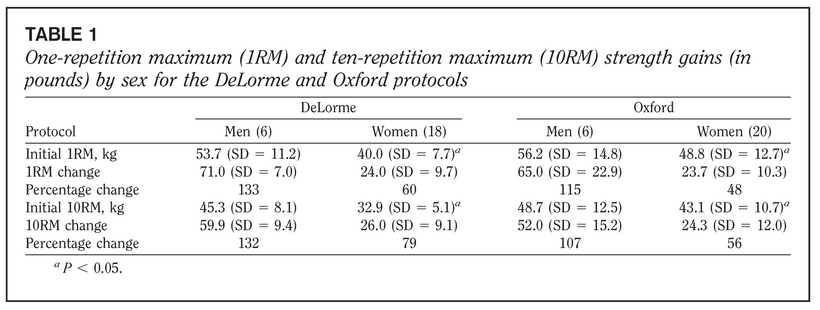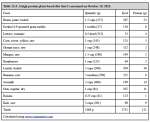Reverse Pyramid Training
Reverse pyramid training is also known as the Oxford method. This method involves performing multiple sets for a muscle group, usually multiple sets of a single exercise, starting with the highest load on the first set and reducing the load on subsequent sets. One might also call this a drop set method.
Conventional pyramid training involves multiple sets of a given number of repetitions, increasing the load on each subsequent set. Compared to the conventional pyramid method, also known as the DeLorme method, reverse pyramid training (the Oxford method) is a more logical way to load over multiple sets for a single exercise.
The DeLorme method involves starting with a set of 10 repetitions with 50% of the 10RM, then doing a second set of 10 with 75% of the 10RM, and finally finishing with a set of 10 with the 10 RM.
Reverse pyramid training was developed by Zinovieff after he attempted to implement the DeLorme technique in practice. Zinovieff found that with the conventional pyramid method most trainees could not complete the last set of predetermined 10RM due to fatigue accumulated in the first two "warm up" sets. He developed the reverse pyramid training technique to overcome this limitation. Zinovieff prescribed starting the training session with the predetermined 10RM, then decreasing the load to 75% of 10RM (i.e. about 56% of 1RM) on the second set, and 50% of 10RM on the third set. Zinovieff suggested that this method best aligned with the natural process of progressive fatigue, and also believed that this method adheres to the progressive overload principle because each set would continue to impose demands taxing the muscle group's momentary muscular capacity [1].

Table 1 Source: [1]
I am aware of only one published study of the effectiveness of the Oxford method. In this study, the Oxford method was compared to the DeLorme method. This study reported finding no significant difference in strength development between the two training methods [1, Table 1 above].
Why? Because in either method performed as originally prescribed, you end up performing only one effective set.
Only One Effective Set
In the DeLorme method (conventional pyramid) you probably only do one effective set, despite doing three sets. Here’s why.
Let’s say you are able to use 225 pounds for 10-12 repetitions in the back squat. If you use the DeLorme method your routine would look something like this:
115 x 12
160 x 12
225 x 10
The first two sets are not work sets since they involve loads 50% and 25% below what is possible for a set of 10-12 repetitions. A trainee who can squat 225 for 10-12 probably has a 1RM of 300, so 160 is only 53% of his 1RM, below the threshold of 65% of 1RM needed for best strength and mass gains. If they are not hard sets, they do not present a challenge to the physiology and will not stimulate strength or mass gains. Moreover, they reduce your capacity on the actual work set. After doing 115 and 160 for 12 repetitions each, it is unlikely you would get more than 10 repetitions on the final set. If you use even higher loads on the first two sets, you will reduce your ability on the last set even more.
Therefore, probably only the last set actually provides overload. Using load x repetitions as a crude measure of the volume of work load placed on your hips and thighs by the last set, we get 2250 pounds. Assuming that 225 is 75% of your 1 RM, you reduced your starting strength by 25%, so this method produces an inroad of 25%.
If you use the Oxford method of reverse pyramid training, your routine would look something like this:
Optional warm up: 115 x 4 (~50% of the top set load x one-third the top set repetitions) plus 160 x 2
Work set 1: 225 x AMRAP (let’s say it was 12)
Work set 2: 170 x 12 or AMRAP (load reduced by 25%)
Warm-ups do not stimulate any gains in strength or mass because they don’t challenge your strength. If they do challenge your strength then they aren’t warm-ups. Thus, if you do reverse pyramid training, you should use a very light weight and do less than half the target repetitions of the top set.
Since you haven’t depleted your energy reserves with two submaximal sets in a conventional pyramid, you can achieve 225 x 12 on the first work set. This is better than the regular pyramid (DeLorme method) because you are able to impose a greater load on your musculature by using the heaviest load on the first set when you have the most energy. Your work load volume is 2700 pounds.
After a 2 minute rest and removing 25% from the load, you perform 170 x 12. Probably this will be very easy since 170 is only ~55% of your 1RM (you probably could perform more than 20 reps). Staying so far from failure means you probably will not demand high force production from the muscles so it probably won't stimulate strength or mass gains. If you then reduce the load to 50% of your 10RM and perform 12 repetitions, you will now be using only 153, which is only about 50% of your 1RM and you find it even easier to complete the 12 rep set. Hence, using the original Oxford method of reverse pyramid training you may only perform one effective set.
Thus, I believe that the reason Fish et al found that the DeLorme and standard Oxford methods produce similar results is this: in either protocol, only the set done with the heaviest load strongly stimulates the body. The rest of the sets just drain energy reserves and make your training session longer without providing further stimulus. You probably are wasting your time doing sets that do not provide overload and therefore can't produce improvements in strength or size.
A Better Reverse Pyramid Training Protocol
To make a reverse pyramid training protocol more effective, you should reduce the degree of load reduction from the first to second sets from 25% to only 10%. For example:
Optional warm up: 115 x 4 (~50% of the top set load x one-third the top set repetitions) plus 160 x 2
Work set 1: 225 x AMRAP (let’s say it was 12)
Rest 2 minutes, reduce load by only 10%
Work set 2: 200 x 12 or AMRAP
If again we assume that 225 is 75% of your 1 RM, your 1 RM is 300. Therefore,the second set at 200 is 66% of your 1 RM, which is a load still capable of stimulating strength gains if you perform as many reps as possible or at least the same number as on the first set.
If you chose then to do a third set with another 10% reduction of load, i.e. 180 x 12, you would still be using 60% of your 1RM. Given the accumulated fatigue, this would be an effective load compared to the 50% of 1RM you would use on the third set following the original Oxford method.
With this modification of the Oxford method of reverse pyramid training, at the completion of the second set, you have completed a total volume of 2700+2400+2160=7260, whereas the DeLorme method results in a volume load of only 5550. This might stimulate slightly more strength and muscle gains than the DeLorme method or single-set training, especially for the 60% of people who have a genotype that may respond best to multiple sets per muscle group [4].
Reverse Pyramid Training
Muscles develop in strength and size when they are made to contract against a resistance high enough to require a maximal or near maximal effort which produces muscular fatigue. A muscle's strength and size is proportional to the level of resistance the muscle can overcome.
In the conventional pyramid training method (DeLorme method) only the final set involves the muscles contracting against a resistance high enough to require a maximal or near maximal effort, and that set alone provides the highest level of resistance the muscle can overcome. Therefore, only the last set in a conventional pyramid training session is an effective set.
In reverse pyramid training, the first set provides the highest level of resistance the muscle can overcome, and since that set involves the muscles contracting against a resistance high enough to require a maximal or near maximal effort, the first set in a reverse pyramid training session is the most effective set.
Although the completion of three sets in reverse pyramid training fashion produces a greater inroad than completion of only one set, this also means you have depleted your starting strength to a greater degree. Although some people may need more time to recover from a 33% inroad than from a 25% inroad, some may not, since muscles with high ratios of type 1, fatigue-tolerant fibers also recover more quickly than muscles that have a high ratio of type 2 fibers.
Drop Sets: Reverse Pyramid Training Without Rest Periods
Drop sets involve performing a set of AMRAP with a given resistance, then immediately reducing the load and again performing AMRAP. Essentially, this is reverse pyramid training with little or no rest between sets. This makes reverse pyramid training more time-efficient.
As with multi-set reverse pyramid training, drop sets produce a deeper inroad into starting strength, but in a much shorter period of time.
If you rest 3 minutes between sets doing 3 sets in a reverse pyramid, and each set takes 1 minute to complete, the training session will take 9 minutes from start of the first set to end of the last set.
You can produce that same level of inroad in less than 2 minutes by doing a drop set. Simply, do a set to failure or AMRAP at about 1 minute of time under load, immediately reduce the load by 25% and do AMRAP, which will take perhaps 20-30s, then reduce the load again to 50% of the original load, and do AMRAP again, which will likely take only 15-20s, but let's say it takes another 30s. Now you have reduced your starting strength (relative to 1RM) by about 33% in 2 minutes rather than 9 minutes. This is much more demanding than the regular reverse pyramid.
When Fisher et al compared the results produced by conventional training with a single set to momentary muscular fatigue (AMRAP to failure) to those produced by single drop (breakdown) sets, they found no statistically significant difference [2]. However, this study may have had too few subjects to detect statistically significant differences between the groups.
In another study, Giessing et al compared the results of training with single sets to momentary muscular failure plus two drop sets to training with multiple (3) sets carried out to a self-determined repetition maximum (voluntary "failure") [3]. Although the drop-set group completed less training volume, with the 3-set system taking 2 to 3 times as long to complete, the high intensity training (HIT) group experienced greater gains in both performance and muscle mass. These results suggested that although the drop sets increased both inroad and training volume for the HIT group, it was not the volume but the intensity – i.e. training to momentary muscular failure – or the inroad that produced the improved results.
Reverse Pyramid Training – Who Benefits?
Remember, you are genetically unique so your personal results might be different. We have evidence that due to genotype, some people may respond better to multiple sets per muscle group, rather than single sets [4]. Hence, some people may find that some muscle groups respond best to multiple sets (2 or 3 rather than 1). In such cases it may be preferable to use multiple exercises, each for a single set, because this may engage different motor units and produce greater strength gains and more homogeneous muscle growth [5].
This is automatically a
type of reverse pyramid training because fatigue produced by the first
set (first exercise) will reduce the amount of load you can handle on
the second exercise compared to what you would handle if you performed
the second exercise before the first. For example, if you do chin ups
to failure, rest, then do a set of ring rowing, you will need to use
less load on the rowing than you would if you did the rowing first, when
fresh.
In some cases it is best to repeat the same exercise, because it is the most effective or safest exercise, or no other equipment is available, or no other exercise is really possible, or you just prefer one exercise to available alternatives. In these cases I recommend performing multiple sets (2-3) of the chosen exercise using a reverse pyramid method with load reductions of 10% per set because this will enable you to use the highest load and get the deepest inroad.
Summary
In short, although we lack scientific evidence that a reverse pyramid training method, either as multiple sets or through drop sets, produces statistically better outcomes than other methods, the published relevant evidence either tested the Oxford method which has a major flaw (excessive load reduction from set to set) or doesn't account for individual genetic variables.
Notes
1. Fish DE, Krabak BJ, Johnson-Green D, deLateur BJ. Optimal resistance training: Comparison of DeLorme with Oxford techniques. Am J Phys Med Rehabil 2003;82:903-909.
2. Fisher JP, Carlson L, Steele J. The effects of breakdown set resistance training on muscular performance and body composition in young men and women. J Strength and Conditioning Research 2016 May;30(5):1425.
3. Giessing J, Eichmann B, Steele J, Fisher J. A comparison of low volume “high-intensity-training” and high volume traditional resistance training methods on muscular performance, body composition, and subjective assessments of training. Biology of Sport. 2016;33(3):241-249. doi:10.5604/20831862.1201813.
4. Colakoglu M, Cam FS, Kayitken B, Cetinoz F, Colakoglu S, Turkmen M, Sayin M. ACE genotype may have an effect on single versus multiple set preferences in strength training. Eur J Appl Physiol. 2005 Sep;95(1):20-6. Epub 2005 Jul 8. PubMed PMID: 16003539.
5. Ugrinowitsch, Carlos. "Changes in Exercises Are More Effective Than in Loading Schemes to Improve Muscle Strength." Journal of Strength and Conditioning Research 28.11 (2014): 3085–3092-3085&ndash-ndash;3092-3085–3092.
Recent Articles
-
Ancient Roman Soldier Diet
Apr 14, 25 05:19 PM
A discussion of the ancient Roman soldier diet, its staple foods and nutritional value, and a vegan minimalist version. -
High Protein Chocolate Tofu Pudding
Jul 01, 24 12:41 PM
A delicious high protein chocolate tofu pudding. -
Vegan Macrobiotic Diet For Psoriasis
Sep 05, 23 06:36 PM
Vegan macrobiotic diet for psoriasis. My progress healing psoriasis with a vegan macrobiotic diet. -
How Every Disease Develops
Aug 04, 23 06:22 PM
How every disease develops over time, according to macrobiotic medicine. -
Why Do People Quit Being Vegan?
Jun 28, 23 08:04 PM
Why do people quit being vegan? How peer pressure and ego conspire against vegans. -
Powered By Plants
Mar 16, 23 08:01 PM
Powered By Plants is a book in which I have presented a lot of scientific evidence that humans are designed by Nature for a whole foods plant-based diet. -
Carnism Versus Libertarianism
Dec 30, 22 01:55 PM
Carnism Versus Libertarianism is an e-book demonstrating that carnism is in principle incompatible with libertarianism, voluntaryism, and anarchism. -
The Most Dangerous Superstition Book Review
Nov 15, 22 08:46 PM
Review of the book The Most Dangerous Superstition by Larken Rose.











